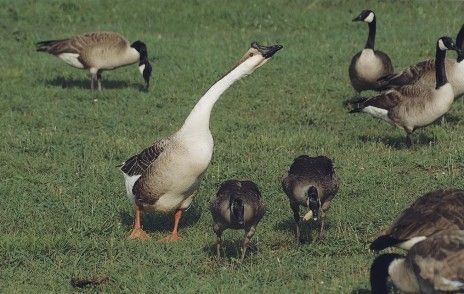
Thw swan goose with the two goslings that were with him at the end.
The lake near City Hall is quiet. There are no ear-splitting honks or loud shrills to break the monotony.
The big white Asian swan goose that graced our city park for years is gone—his remains found near the cemetery he grazed, a pair of goslings by his side. He would have liked that, knowing the eight-month-old babies were there at the end.
He was the lake's resident nanny, helping two sets of Canada geese parents raise their young. Over the years, he had become almost a fixture, a legend among geese, controlling both the lake and its inhabitants—human and otherwise. Their actions provided a solace, a release from stress. He was also the undisputed leader of some 200 Canada geese that flew in and out, prompting noisy reunions among avian pals that hadn’t seen each other in months.
I called him King but he was also known as the "leader" goose or "Noisy" because of his seductive, non-stop honking. Others called him the old granny because of his affinity for the young. I thought him male because his behaviors were similar to those of the ganders—protective and assertive; yet there was no disputing his gentleness toward the babies. Occasionally the Canada geese dads would cuff their offspring to keep them in line but the swan goose was always gentle, generously sharing his food with the goslings, if not giving it up to them entirely.
He was twice the size of a Canada goose, mostly white with pumpkin-colored feet, brown wings and matching stripe down the neck and a conspicuous black bulb at the base of the bill. Whatever, he was gorgeous, with an enormous following among residents. Visitors brought him treats. Children adored him. People flocked to watch him perform.
The sandbar near the bridge was his. He'd swim over, nudging off anyone not part of his personal entourage, then dance around like a ballerina, spreading those slow, glorious wings in some sort of celebratory rite, a dozen Canada geese cooing in chorus, an avian version of "Swan Lake ". Visitors would gather on the bridge and watch in awe.
I probably knew him better than anyone. He hung out with Zoey, a Canada goose whose behaviors I'd been studying for six years, and her mate Dad.
He could fly but not high enough. Eventually the goslings had to fledge their wings and that meant King was left behind. He'd fly low across the lake with the family and then honk his despair when he couldn't follow them into the vast wilderness. He was restless in their absence but the reunions were something to behold. Zo and Dad would begin voicing their arrival from half a mile away, and King would honk them in, swimming toward them in a great rush. Once I was with him on shore when they flew in. To my astonishment, the family practically landed at our feet, enveloping us both in a sea of feathers and unrestrained joy.
I had a curious relationship with him over the years. Unlike Canada geese, who adore humans they trust, he was not of that ilk
. I spent months trying to win him over. One day it dawned on me that he didn't like anyone towering over him, so I began getting down to his level, as you would a child. I'd kneel down to feed Zo and the goslings and eventually he'd amble over, coming so close I could reach out and touch him. It was an opportunity to observe him close up. He had such regal bearing and rare intelligence. Sometimes I'd catch him studying me with those gentle eyes whose color I could never quite discern and wonder what he was thinking.
Of late, he had developed a habit of coming over and standing in front to let me know he wanted Nabisco cheese crackers. Maybe it was the salt, I don't know, but they were the undeniable treat. Considering then junk food, I handed them out sparingly but I carried a box for him all the same.
The memories piled up over the years. One day I was photographing several of Zo's three-week-old babies as they vacillated between sleep and silliness on shore when I noticed that the parents had disappeared. Even the nanny had vanished. I stood up, scanning the horizon, finally spotting them well beyond the bridge. They'd gone swimming!
"I guess I'm the unofficial babysitter," I mumbled to the goslings, who were by then asleep. Canada geese parents never ever leave their young and I knew I had been instilled with a rare trust. There were predators nearby but I would never have left the babies alone, and I suspect the parents knew that.
Months after his death, the lake still isn't the same. Maybe it never will be. The goslings seem to miss him the most. Their nanny slept between them, one on either side, and some evenings I catch them looking off into the distance as if they think he's suddenly going to pop out from behind one of the tombstones. I'd give anything if I could make that happen.
In time, the sadness will subside. The goslings will go back to being their bratty selves, and the dozens of Canada geese that fly in expecting reunions will cease waiting for his great bulk to appear.
But for now his spirit is everywhere. I'll be walking and suddenly hear the faint beginnings of a honk and instinctively look up, thinking it's him, and then I'll remember...it can't be him..
.
It is worth noting how attached we can become to a creature of the forest, one that allowed us, in this case, to observe the almost human-like interactions of wild geese—private moments between goose and gander...the extraordinary sense of family...the clamorous honking—and not feel privileged to have known this celebrated community goose if only for a while.
